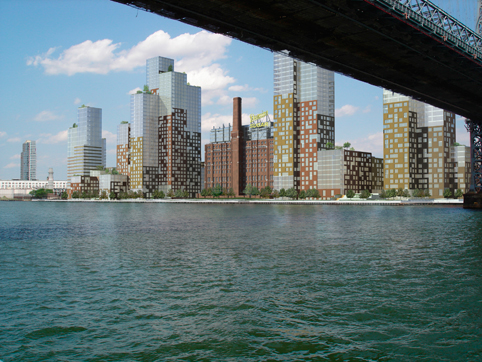The Next New York: How NYC Can Grow as a Walkable City
This is the conclusion of a three-part series on the
reshaping of New York City and its consequences for sustainability and
livable streets. Here’s where to catch part one and part two.
 Will City Planning Commissioner Amanda Burden foster walkable development and livable streets in her third term? Image: Wikipedia.
Will City Planning Commissioner Amanda Burden foster walkable development and livable streets in her third term? Image: Wikipedia.In the last eight years, the Department of City Planning has rezoned 20 percent of New York along relatively transit-oriented lines, while simultaneously promoting quasi-suburban projects at prominent sites and maintaining parking minimums that erode the pedestrian environment. In other words, the planning department is promoting growth in the right places, but enabling the wrong kind of development.
The rezonings are not stopping. The department recently announced plans to rezone two underutilized commercial corridors in the Bronx for mixed-use development. Planners also continue to facilitate mega-projects in conjunction with the NYC Economic Development Corporation, like the redevelopment of Willets Point in Flushing.
So in the next four years, will New York’s planners adopt more sustainable practices or continue the status quo? The department’s clear awareness of the need for transit-oriented, sustainable growth gives hope for improvement. But the experts Streetsblog spoke to all agreed that change is needed.
One frequent criticism of the department is that city planners employ a piecemeal approach, without using all the tools at their disposal. "There’s a joke about the Department of City Planning," said Joan Byron of the the Pratt Center for Community Development, "that
they’re really the Department of City Zoning."
The sentiment that "rezonings are not enough" was shared by many. Planning "shouldn’t be a sporadic, ad-hoc thing, but a comprehensive approach," said Ron Shiffman, a co-founder of the Pratt Center for Community
Development and a former planning commissioner. "I thought that’s what PlaNYC 2030 would help us do."
Shiffman urged the incorporation of transit planning earlier in the development process. "They should be putting in transit lines that are guaranteed prior to the development," he said. "There should be a rider and seat evaluation before any redevelopment or any very high-density rezoning."
"The fact is that we’re not trying to leverage our transit system to create more pedestrian or transit-oriented environments."
Jonathan Bowles, the director of the Center for an Urban Future,
generally agreed. "For several of the rezonings," he said, "there
should have been more transportation planning."
City agencies are not strangers to the idea of getting developers to help finance expanded transit service. Just this month, EDC president Seth Pinsky signaled his agency’s interest in "value capture" — channeling some of the value of real estate development into the addition of transit capacity. Interestingly, Shiffman identified Hudson Yards and the 7 Line
extension as one of the only places where this has occurred, although
he doesn’t endorse the entire project.
Another repeatedly voiced suggestion is that the planning department needs to do more to address flaws embedded in the entire zoning code, rather than focus mainly on
individual rezonings. "There will still be opportunities to continue these targeted
rezonings," said L. Nicolas Ronderos of the Regional
Plan Association, "but moving forward I’d like to see more technical revisions
to the underlying code."
On that score, revising the 50-year-old off-street parking
requirements in the zoning code would present a huge opportunity for
sustainability and livable streets.
 The Domino Sugar redevelopment in North Brooklyn, now undergoing public review, would construct 1,694 new parking spots. Image: thenewdomino.com.
The Domino Sugar redevelopment in North Brooklyn, now undergoing public review, would construct 1,694 new parking spots. Image: thenewdomino.com.
Eighteen months ago, a broad coalition of environmental, transportation and planning advocates called on the planning department to implement a package of parking reforms [PDF]. While the department has begun to study some of the questions raised by these groups, no concrete reforms have been enacted.
The parking reform recommendations, which accompanied the release of the report Suburbanizing the City, urge the city to eliminate parking minimums, institute parking maximums near transit, stop subsidizing the construction of parking, and separate the price of parking from the price of housing (which can make housing more affordable while discouraging the purchase and construction of parking).
The key, said report co-author Rachel Weinberger, is to connect the planning department’s transit-oriented zoning to a transit-oriented parking policy. "Even while our parking minimums are generally quite low," she said, "the fact is that we’re not trying to leverage our transit system to create more pedestrian or transit-oriented environments around transit stations."
Off-street parking reform must overcome the territorial instinct of car owners who fear increased competition for on-street space. It’s not an easy political lift. And reforming the mega-project approach to redevelopment will require a tougher stance with private sector builders, guided by a firmer vision for the future of the city.
Both tactics are necessary to deliver on the sustainability goals of PlaNYC. To do it, Mayor Bloomberg will have to show the same backbone he’s displayed in his public health initiatives. "If you’re the kind of tough love mayor that has the guts to ban smoking and transfats," argued Joan Byron, "you should be able to look the developers in the eye and tell them that it’s a new world. If you won’t develop a good urban environment, others will."